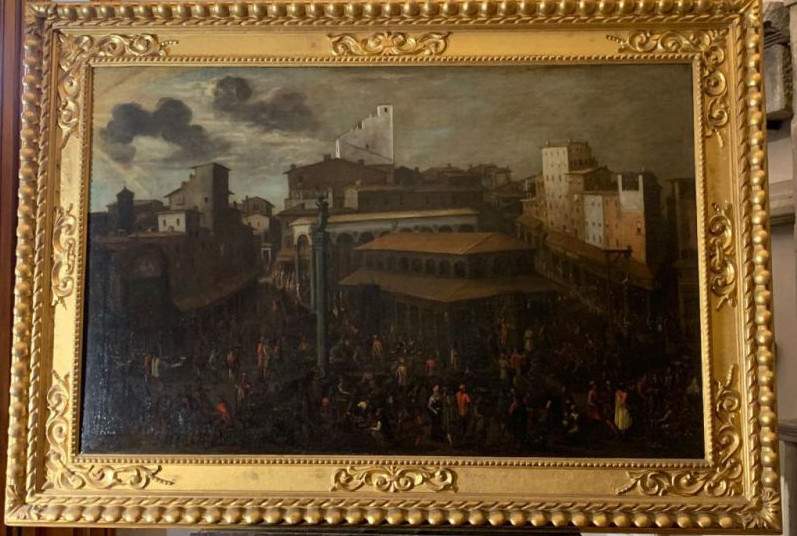Major acquisition for Museo di San Marco: a view attributed to 17th-century Florentine artist
The Ministry of Culture has purchased for the Regional Directorate Museums of Tuscany and the Museum of San Marco in Florence the large painting with the View of the Old Market Square in Florence. It is a new work that enriches the collection of the Ancient Florence section of the San Marco Museum, which displays fragments of the old medieval Florentine center, demolished between 1881 and 1890 in the name of public hygiene and for the creation of the vast Piazza today known as Piazza della Repubblica, in the years that followed the brief season of Florence as the capital of Italy.
The large Veduta della Piazza del Mercato vecchio di Firenze (oil on canvas, 156 x 221 cm), attributed to a Florentine painter of the first half of the 17th century, probably replicates a painting by Filippo Liagno, known as Filippo Napoletano, who was in the service of the Medici court in Florence between 1617 and 1621. The original of this view is mentioned in 1684 by historian Ferdinando Leopoldo Del Migliore, in his Firenze città nobilissima illustrata, where he also mentions several copies found in the city’s noble residences, one of which is to be recognized in the painting now in San Marco.
The public presentation of the painting will be held on Wednesday, March 15, 2023 at 5 p.m. with Stefano Casciu, regional director of museums of Tuscany, Angelo Tartuferi, director of the Museum of San Marco, together with Maria Sframeli, an art historian who has studied the rich material from the destroyed center of Florence and largely preserved in the Museum of San Marco. Free admission subject to availability.
“This is an important acquisition,” says Stefano Casciu, “which allows us to document the Florence that disappeared after the post-unification destruction, and which appropriately complements the collection of stone and wooden artifacts from the ancient center set up in the Foresteria wing of the San Marco Museum, allowing for an effective visualization of the demolished area and an extremely fascinating contextualization of the artifacts themselves.”
“About the new painting,” Angelo Tartuferi points out, “one might well say ’the right work in the right place.’ Visitors to the museum will now have at their disposal a valuable visual document to contextualize in a very effective way the artifacts from the Old City of Florence displayed in the corridor of the monastery’s Old Guest House and in the rooms adjacent to it.”
The painting, now on display in the first room of the Antica Foresteria, was first presented to the public in 1986, on the occasion of the exhibition Il Seicento Fiorentino, curated by Mina Gregori at Palazzo Strozzi. Maria Sframeli, a noted connoisseur of Florence’s ancient remains and editor of the seminal volume Il Centro di Firenze restituito (1989), analyzed the painting’s urban landscape in detail.
Under a wintry sky, brightened on the left by a ray of sunlight, in addition to the dense fabric of destroyed medieval buildings, of which one can recognize the arched entrance to the Jewish ghetto and many burgher palaces: the Palazzo Tosinghi, known as the Palagio, the Palazzo della Luna, known as the Casone, the Palazzo Armieri, the towers of the Caponsacchi, and many other common houses, a teeming humanity animates the streets and bustles near the Old Market. A colorful crowd of gentlemen, gentlewomen, shopkeepers, artisans and small traders, perfectly at ease in the shadow of palaces noble residences and seats of the ancient Corporations.
In the center can be recognized the Column of Abundance, which stood at the exact intersection of the cardo and decumanus, the forum of the Roman city, on which was placed Donatello’s statue, replaced in 1721 by another statue with the same subject, executed by Giovan Battista Foggini.
The two loggia buildings that dominate the scene are the 14th-century Beccheria and Vasari’s Loggia del Pesce of 1568-69. The Beccheria, a large covered portico home to the slaughterhouse and meat market, was demolished in 1881; while the Loggia del Pesce was dismantled and then rebuilt in Piazza dei Ciompi only in 1955. Around these two lodges the other activities of the market took place in stalls and other temporary structures.
The large quantity of artifacts, coats of arms, sculptural, architectural, and decorative elements recovered from the demolitions is now largely preserved and exhibited in the Museum of San Marco, while the archaeological finds that emerged during the redevelopment, from the excavations that resulted from the construction of the new buildings, were housed in the Archaeological Museum of Florence even at that time and placed, according to a nineteenth-century taste, in the so-called Cortile dei Fiorentini.
 |
| Major acquisition for Museo di San Marco: a view attributed to 17th-century Florentine artist |
Warning: the translation into English of the original Italian article was created using automatic tools. We undertake to review all articles, but we do not guarantee the total absence of inaccuracies in the translation due to the program. You can find the original by clicking on the ITA button. If you find any mistake,please contact us.





























